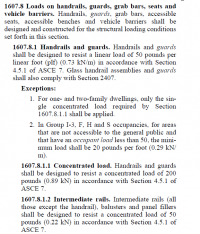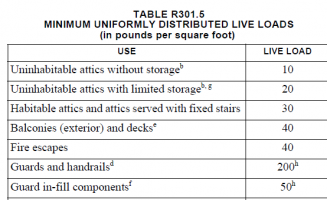tbz
Silver Member
Ok this has been a long time discussion I keep having over and over with architects, engineers and contractors about an inspectors limits on inspection and whether its a request for compliance or failure notice.
I have always been told and been under the understanding that inspectors can't personally perform a structural load test on a guard or handrail and as such if they feel the guard or handrail feels unsafe they issue a failure notice based on an assumption, not a fact and then request verification of compliance.
I have an inquiry about a inspector failing a guard installation for deflection, not anything I did, I get calls for help like this all the time. My understanding is if they are doing an inspection and feel the guard wiggles or deflects a little bit more than they feel comfortable with, the inspector then issues a notice that they are not signing off and passing the guard and or handrail until the owner/contractor can produce a engineers compliance letter that they have inspected and confirmed that the guard as constructed and in place meets or exceeds the enforced building code for the jurisdiction or stabilizes the guard to the touch of the inspector willingness to now issue the C/O.
How do you all figure/inspect for deflection as a violation within the code during a visual inspection of a guard and note it as a failure and then treat it. Also is there specifically a deflection requirement to be met for guards within the IBC structural that I am missing for this type of violation notice?
Please don't be bashful on this, trying to get to a long standing revolving door issue solved or maybe look at a proposal for next cycle to clear this up better.
Regards - Tom
I have always been told and been under the understanding that inspectors can't personally perform a structural load test on a guard or handrail and as such if they feel the guard or handrail feels unsafe they issue a failure notice based on an assumption, not a fact and then request verification of compliance.
I have an inquiry about a inspector failing a guard installation for deflection, not anything I did, I get calls for help like this all the time. My understanding is if they are doing an inspection and feel the guard wiggles or deflects a little bit more than they feel comfortable with, the inspector then issues a notice that they are not signing off and passing the guard and or handrail until the owner/contractor can produce a engineers compliance letter that they have inspected and confirmed that the guard as constructed and in place meets or exceeds the enforced building code for the jurisdiction or stabilizes the guard to the touch of the inspector willingness to now issue the C/O.
How do you all figure/inspect for deflection as a violation within the code during a visual inspection of a guard and note it as a failure and then treat it. Also is there specifically a deflection requirement to be met for guards within the IBC structural that I am missing for this type of violation notice?
Please don't be bashful on this, trying to get to a long standing revolving door issue solved or maybe look at a proposal for next cycle to clear this up better.
Regards - Tom




